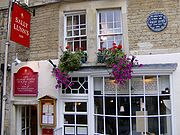
Sally Lunn bun
Encyclopedia

West Country
The West Country is an informal term for the area of south western England roughly corresponding to the modern South West England government region. It is often defined to encompass the historic counties of Cornwall, Devon, Dorset and Somerset and the City of Bristol, while the counties of...
of England
England
England is a country that is part of the United Kingdom. It shares land borders with Scotland to the north and Wales to the west; the Irish Sea is to the north west, the Celtic Sea to the south west, with the North Sea to the east and the English Channel to the south separating it from continental...
, the recipe for which is said to have arrived with a French émigrée in the 17th century. It is often lightly scented with lemon, and is traditionally served sliced horizontally, spread with butter or whipped or clotted cream and reassembled. It is still produced commercially in Bath.
History
Locals would have you believe that the bakery now known as Sally Lunn's House is where Mrs Lunn baked her original buns. The truth is that the story about Sally Lunn's association with 4 North Parade Passage was invented between 1934 and 1937 by an artist called Marie Byng-Johnson.Ms Johnson had arrived in Bath a few years earlier with her daughter, a violin teacher, and for a while they traded from premises in the Abbey Court Yard. At that time 4 North Parade Passage was a grocer's, having previously been a lodging house and cab hire office. The grocer's closed in about 1934 and the building fell into a derelict state. This claim can be contested though by the findings of the various kiln's used to bake bun found in the basement of the house which also acts as a museum now.
2 or 3 years later Ms Byng-Johnson took a lease on the premises and dreamed up the story of Sally Lunn. She published a little pamphlet in which she describes finding, in a hidden void naturally, the story of Sally Lunn and the secret of the bun. Despite chancing upon this absolute treasure of historical record, she contrived to lose it, so there is no proof that it ever existed.
The recipe for this bun is said (by the Byng-Johnsons) to have originated in Bath with the arrival in 1680 of a Huguenot
Huguenot
The Huguenots were members of the Protestant Reformed Church of France during the 16th and 17th centuries. Since the 17th century, people who formerly would have been called Huguenots have instead simply been called French Protestants, a title suggested by their German co-religionists, the...
immigrant called Solange (Sollie) Luyon who (according to the Byng-Johnsons) brought her native skill and worked at a Bath bakery
Since 1990 the building has been known as Sally Lunn's House and can be visited today with the original (1937) recipe buns available for sale or consumption in the dining rooms.
Sally Lunn buns were certainly consumed in Georgian England but whether the name "Sally Lunn" refers to an individual is questioned by many. A widely believed alternative version is that the name is derived from "soleil lune" or "Sol et Lune" due to the shape and colour of the buns; but it may simply be rhyming slang for the word "bun". There is a reference in Charles Dickens
Charles Dickens
Charles John Huffam Dickens was an English novelist, generally considered the greatest of the Victorian period. Dickens enjoyed a wider popularity and fame than had any previous author during his lifetime, and he remains popular, having been responsible for some of English literature's most iconic...
(1812–1879) short novel The Chimes, about a drear evening as "the sort of night that's meant for muffins. . . Likewise crumpets. Also Sally Lunns
This bun or bread recipe also became a favorite in the American Southern colonies.
It remains a locally produced speciality in the 21st century with imitations throughout the English speaking world. It is often confused with the Bath bun
Bath bun
The Bath bun is a rich, sweet yeast dough shaped round that has a lump of sugar baked in the bottom and more crushed sugar sprinkled on top after baking...
.
There are various types of Sally Lunn worldwide. In New Zealand it usually has a layer of pink icing on top of it. Many children remember this delicious treat as a fond memory.

